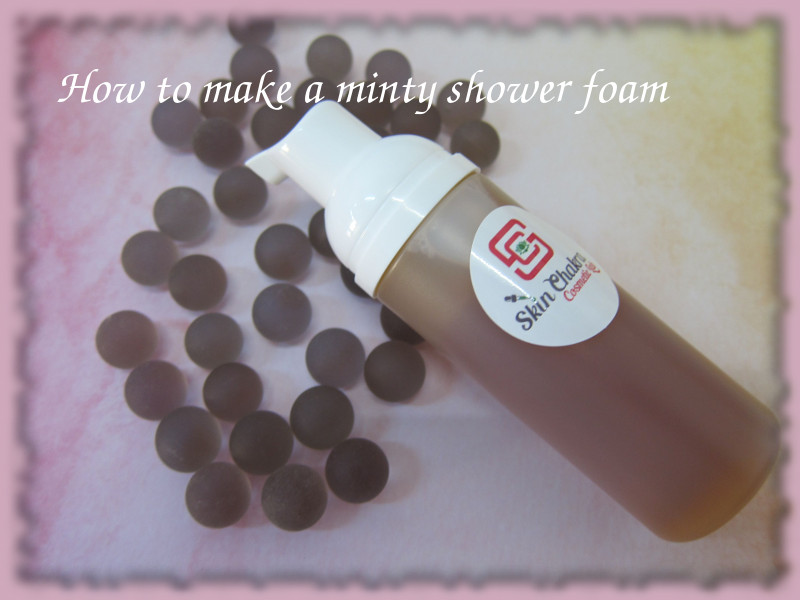
Donnerstag, 9. August 2018
How to make a minty, refreshing shower foam
It seems as if we're going to have still a few more such hot days till the end of summer and since I personally am obsessed with foam formulations, I'm going to share this easy to make but mind blowing (and literally cool) shower foam with you.
I love foams because they are quite easy to make. No hassle with viscosity adjustment and gum dispersion. You need much lower concentration of surfactants to achieve a lovely foam with a pleasant texture and the same cleansing properties. You can even use this foam for hair washing if you have short hair.
What you need to consider and take care of:
since the surfactant concentration is low, it is possible that it can not solubilize your essential oil.
Check this in a sample formulation in a low scale (30-50 gr) before you make your first real batch. Check whether the surfactants can solubilize your essential oils (the foam must be completely clear. if it turns cloudy or you can observe a layer of oil separated on top of the water phase then your surfactant concentration is not enough to solubilize the essential oils. you'll need some solubilizer to incorporate the essential oils)
If the foam is clear, test the efficacy of the surfactant by putting samples:
1- at 40 degrees centigrade
2- In the fridge
for at least one week. A real stability test stretches over 4 weeks and is composed of many other tests but this is a short way to see whether your surfactant concentration, or the solubilizer (if you've added any) is doing its job. If the surfactant or solubilizer concentration are not enough you'll observe at least one of the following issues:
- turbidity or cloudiness
- phase separation
- sedimentation
You may come to the idea to increase your (washing) surfactant concentration to avoid any solubilizer. That's good in the theory but practically and by applying many secondary surfactants you'll increase the viscosity of the liquid and that wouldn't be suitable for a foam dispenser anymore. This is why we have to use the magic of a solubilizer.
To make it short, we know that this surfactant concentration we've used here creates a lovely dense foam and is capable of cleansing body and short hair completely but it isn't enough to solubilize our essential oil blend that seems to be a little bit tricky. This is why we have used a blend of:
- Natural solubilizer clear plus
- Plant based pentylene glycol (as a solubilizer booster)
in this formulation.
Now let's jump to the formulation and procedure.
Formulation:
| Phase A | |
| Peppermint hydrosol | to 100,0% |
| Lemon verbena hydrosol | 30,0% |
| Caffein powder | 1,0% |
| Sodium lactate | 2,5% |
| Sodium PCA | 2,0% |
| Hydroglyceric extracts of alfalfa and fenugreek sprouts | 1,0% |
| Hydroglyceric extract of malva, dandellion and bilberry | 1,0% |
| Aloe leaf powder 1:200 | 1,0% |
| Natural chelator PA-3 | 0,1% |
| PhaseB | |
| Disodium sodium cocoyl glutamate | 15,0% |
| Proteol APL EF | 10,0% |
| Yucca extract | 2,0% |
| Coco glucoside | 2,0% |
| Natural solubilizer clear plus | 4,0% |
| Plant based pentylene glycol | 4,0% |
| Peppermint essential oil | 0,5% |
| Bergamot essential oil | 0,5% |
| Verbena essential oil | 0,5% |
| Phase C | |
| Preservative 1388 eco | 3,0% |
| Versatile preservative BL | 0,5% |
| Lactic acid 80% | to adjust the pH |
Procedure:
1- Blend phase A and B separately in beakers at room temperature. The powders (caffein and aloe) tak a little time to completey disperse. A magnetic stirrer could be quite helpful and time saving for both phases but is not necessary.
2- When both phases are homogeneous, slowly add phase B to A. You don't want to create much foam at this stage. You can still use the magnetic stirrer or an overhead stirrer at a very low setting.
3- We're almost done. We only need to add the preservative and adjust the pH.
4- From experience we know that the pH is between 6-7 and we can add the preservatives at this pH. For your first trial batch, you may need to measure the pH of a 10% dilution of the blend. The pH should be higher than 5,2 when you add the preservtive. If it is lower (which shouldn't be by this surfactant blend), you can increase it by adding low amounts of arginine.
5- Add the preservative blend. Make another 10% dilution in distilled water and re-measure the pH. In our case it was 6,8. You need the final pH to be between 5,2-5,5. Add 80% lactic acid (or citric acid powder) to reduce the pH. Do this step gradually and little by little. an abrupt pH reduction may cause an irreversible cudiness.
6- Take your stability and micro kit samples and fill the rest in a suitable foam dispenser.
Enjoy the lish texture of the foam and the refreshing skin feel.
BeHappy and have Fun


